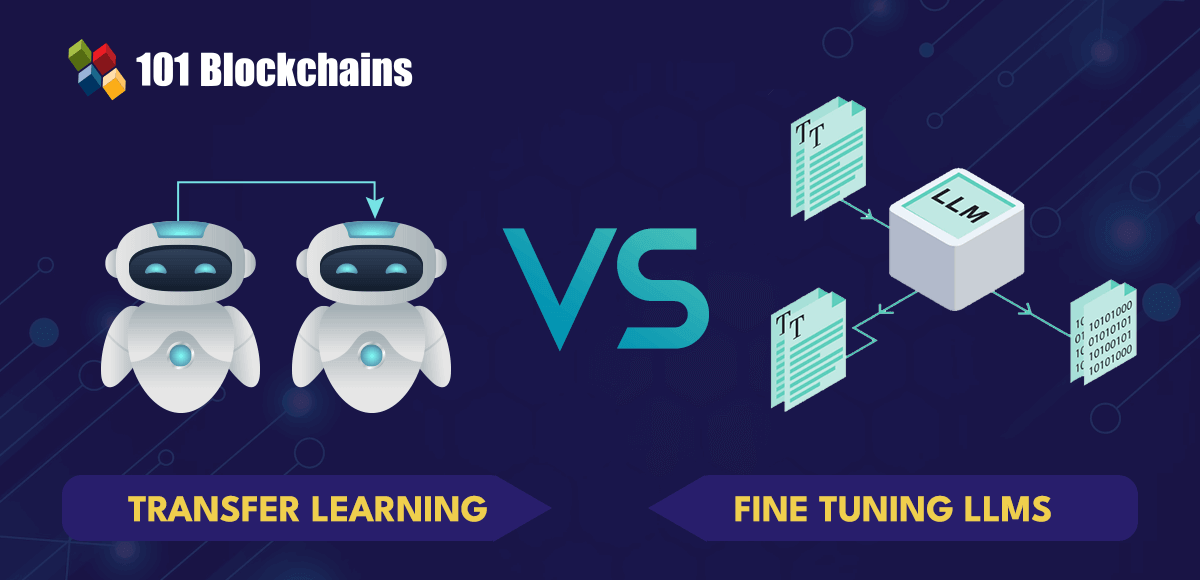Transfer Learning and Fine-Tuning LLM: Key Differences

The two most prominent techniques that define the capabilities of large-scale language models, or LLMs, are fine-tuning and transfer learning. Each technique is useful for large, pretrained language models. Before we dive deeper into the transfer learning and fine-tuning debate, it is important to note that both approaches help users leverage the knowledge of a pre-trained model.
Interestingly, it is important to note that transfer learning is also a type of fine-tuning, and the best way to describe it is to think of it as full fine-tuning. Although interconnected, transfer learning and fine-tuning provide distinct goals for basic LLM education. Let us learn more about the differences between them with a detailed impression of the meaning of both the technologies.

What is transfer learning?
The best way to answer the question “What is the difference between transfer learning and fine-tuning?” involves learning about both techniques. Transfer learning is an important concept when using large-scale language models, or LLMs. This includes using pre-trained LLMs for new tasks. Transfer learning leverages existing pre-trained LLMs from GPT, BERT, and other families of LLMs trained on specific tasks.
For example, BERT is geared towards natural language understanding, while GPT is built for natural language generation. Transfer learning uses these LLMs to adapt them to different target tasks with distinct similarities. The target task can be a domain-specific variant of the source task.
The main goal of transfer learning is to use knowledge gained from the source task to achieve improved performance on the target task. This is useful in scenarios where there is limited labeled data to accomplish the goal task. It is also important to note that prior training for LLM is not required from the start.
You can learn more about transfer learning vs. fine-tuning by considering the training scope of transfer learning. In transfer learning, only the latter layer containing the model’s parameters is selected for training. On the other hand, the initial layer and its associated parameters are frozen because they represent universal features such as textures and edges.
The training method used in transfer learning is also called parameter efficient fine-tuning, or PEFT. It is important to note that the PEFT technique freezes almost all of the pretrained parameters. On the other hand, this technique implements fine-tuning only for a limited set of parameters. It is also important to remember that transfer learning involves a limited number of strategies, such as the PEFT method.
Do you want to learn the basics of AI applications in business? Enroll in the AI For Business course today
How transfer learning works
The most important highlights needed to discover insights into the fine-tuning and transfer learning debate represent the workings of transfer learning. We can understand the working mechanism of transfer learning in three separate steps. The first step in the transfer learning task is to identify a pre-trained LLM. To handle tasks in the general domain, you should choose a pre-trained model that used a large dataset for training. For example, there is the BERT model.
The next step is to decide for which task you want to implement transfer learning in LLM. Make sure your work matches the original work in some form. For example, it could be about categorizing contract documents or resumes for recruiters. The final stage of LLM training through transfer learning involves performing domain adaptation. You can use a pre-trained model as an initial point for your target task. Depending on the complexity of the problem, you may need to freeze some layers of the model or ensure that there are no updates to relevant parameters.
The working mechanism of transfer learning gives a clear impression of the benefits that can be found through it. Considering the advantages of transfer learning, the fine-tuning transfer learning comparison can be easily understood. Transfer learning offers promising benefits such as increased efficiency, performance, and speed.
See how transfer learning improves efficiency by reducing extensive data requirements for the target task. At the same time, training time is also reduced when working with pre-trained models. Most importantly, transfer learning can help achieve better performance in use cases where the target task has limited access to labeled data.
Unleash the full potential of generative AI in your business use cases and identify new ways to become an expert in generative AI technologies with the Generative AI Technology Path.
Definition of Fine Tuning
As we further explore the differences between transfer learning and fine-tuning, it is important to learn about the next player in the game. Fine-tuning or global fine-tuning has emerged as a powerful tool in the realm of LLM education. Full fine-tuning focuses on using pre-trained models trained using large datasets. The focus is on tuning the model to perform a specific task by continuing the learning process on smaller, task-focused datasets.
Mechanism of operation of fine tuning
A high-level overview of LLM fine-tuning involves updating all model parameters using supervised learning. More clarity can be found in the response to “What is the difference between transfer learning and fine tuning?” Find out how fine-tuning works.
The first step in the LLM fine-tuning process begins with identifying a pre-trained LLM. The next step is to decide on an action. The final step of the fine-tuning process involves adjusting the weights of the pre-trained model to achieve the desired performance on the new task.
Complete fine-tuning relies on massive amounts of computing resources, such as GPU RAM. This can have a significant impact on your overall computing budget. Transfer learning (PEFT) helps reduce compute and memory costs through fixed underlying model parameters. PEFT technology provides better efficiency by fine-tuning a limited range of new model parameters.
Take the first step toward learning artificial intelligence with AI flashcards.
How is transfer learning different from fine tuning?
Large-scale language models are one of the key elements of the ever-expanding artificial intelligence ecosystem. At the same time, it is also important to note that LLMs have evolved and fundamental research into the potential of LLMs provides the basis for new LLM use cases.
The growing emphasis on transfer learning versus fine-tuning shows that how LLMs can be tuned to achieve specific tasks is a key feature of the AI industry. Below is an in-depth comparison between transfer learning and fine-tuning to find the best approach for LLM.
The most important factor when comparing transfer learning and fine-tuning is how they work. Transfer learning involves training a small subset of model parameters or a limited number of task-specific layers. The most prominent topic in all the fine-tuning and transfer learning debate is how transfer learning freezes most model parameters. The most popular strategy of transfer learning is the PEFT technique.
Full fine-tuning works on the exact opposite principle by updating all parameters of the pre-trained model over the course of the training process. how? The weights of each layer in the model are modified based on the new training data. Fine-tuning brings important modifications to the behavior and performance of the model, with a particular focus on accuracy. This process allows LLM to adapt accurately to specific data sets or tasks, even though it consumes more computing resources.
The difference between transfer learning and fine-tuning is clearly evident in the goals. The goal of transfer learning emphasizes applying a pre-trained model to a specific task without significantly changing model parameters. With this approach, transfer learning helps maintain a balance between retaining knowledge gained during prior training and adapting to new tasks. Focus on minimizing task-specific coordination to get the job done.
The purpose of fine-tuning focuses on changing the overall pre-trained model to fit a new dataset or task. The main goal of LLM fine-tuning is to achieve maximum performance and accuracy to achieve a specific task.
Do you want to understand the importance of ethics in AI, ethical frameworks, principles and challenges? Enroll in our Artificial Intelligence (AI) Ethics course now
It can also be differentiated from transfer learning by learning how fine-tuning affects the model architecture. The answer to “What is the difference between transfer learning and fine-tuning?” Highlights how transfer learning only works on existing architectures. This involves freezing most model parameters and fine-tuning only a small set of parameters.
Full fine-tuning completely changes the parameters of the LLM to adapt to new tasks. As a result, the model architecture needs to be completely updated according to the new requirements.
The difference between fine-tuning and transfer learning is that they leave the learning process as an important parameter. Transfer learning involves training only a new top layer while keeping other layers fixed. In the fine-tuning transfer learning debate, attention is often focused on the freezing of model parameters in transfer learning. Only in certain cases does the number of newly trained parameters account for only 1-2% of the original LLM weights.
The curriculum of LLM Fine-Tuning emphasizes the modification of specific layers and parameters to perform new tasks. This involves updating the weights of the parameters according to the new utility of the LLM.
Want to learn about ChatGPT and other AI use cases? Enroll in ChatGPT Basics Course Now
Another factor comparing transfer learning and fine-tuning is the similarity between the source and target workspaces. Transfer learning is an ideal choice for scenarios where the new task domain closely resembles the original or source task domain. This involves a small new data set that leverages the knowledge of a model pre-trained on a larger data set.
Fine-tuning is considered more effective in scenarios where the new dataset is significantly larger, as it helps the model learn the specific features needed for the new task. Additionally, the new dataset must be directly linked to the original dataset.
The discussion of transfer learning versus fine-tuning focuses attention on the requirements for computing resources. Transfer learning is a resource-efficient approach, so it uses limited computational resources. The working principle of transfer learning focuses on updating only part of the LLM.
Limited processing power and memory requirements ensure faster training times. Therefore, transfer learning is an ideal recommendation for scenarios where LLM needs to be trained with limited computational resources and faster experiments.
Refinement works by updating all model parameters. As a result, it requires more computational resources and consumes more time. Fine-tuning increases training time while utilizing more processing power and memory, which increases for larger models. Full fine-tuning typically requires large amounts of GPU RAM, increasing the cost for the LLM training process.
Develop professional-level skills in prompted engineering with the Prompt Engineer Career Path.
final words
Comparing fine-tuning and transfer learning helps us understand the importance of both training approaches. Important highlights should be found in the comparison of fine-tuning and transfer learning, which are important tools for LLM optimization. Transfer learning and fine-tuning, although they have critical differences, can help tune large-scale language models to achieve specific tasks. A deeper understanding of the differences between fine-tuning and transfer learning can help you identify which method is right for your specific use case. Learn more about large-scale language models and the implications of fine-tuning and transfer learning for LLM today.




